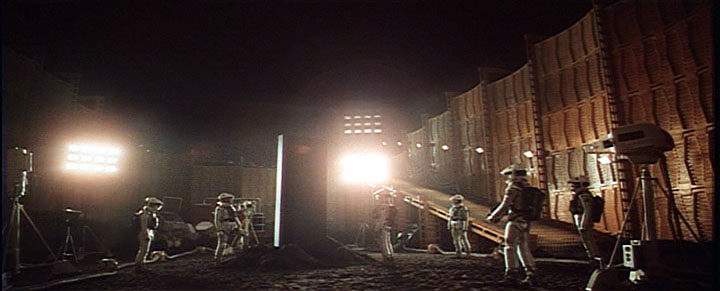2001: A Space Odyssey and the Riemann zeta function
Very few of my friends or acquaintances know much at all about mathematics. As a result of this, I have repeatedly found myself struggling to explain to them what it is that I am studying and quite clearly very excited about.
I have been able to develop a helpful metaphor involving a very widely known film: Stanley Kubrick's 1968 production of 2001: A Space Odyssey, based on the acclaimed science-fiction novel of the same name by Arthur C. Clarke.
A quick look around the Internet will reveal that the film has a widespread cult following, and seems to induce an almost religious sense of awe in certain viewers. I should point out that I'm not an avid reader/viewer of science-fiction, and I only saw 2001 in 2001 when it did the cinema rounds (for obvious reasons). I read the novel shortly after that, and although I was very impressed, and my thoughts were provoked, I haven't become part of the cult following.
If you haven't seen the film, there are many plot-summaries available online, such as this. For the purposes of this metaphor, I will summarise the relevant points:
The pivotal event within the story is the discovery of a giant rectilinear, homogeneous slab
which had been beaming out a high-energy radio signal from
beneath the surface of the moon, seemingly buried some four million years earlier. The slab (which
the scientists call "TMA-1", but is generally referred to as 'the monolith') is unearthed
and stood upright in a top-secret lunar-archaeological zone. A team of space-suited experts
arrive to see it for the first time, approaching in awed silence.

This is a very powerful bit of film. There's this enormous sense of "WHERE THE HELL DID THAT COME FROM??" - extreme, collective, cognitive dissonance mixed with sheer awe. The scientists eventually pose for a photograph, a somewhat surreal moment which is suddenly shattered when the monolith emits a sudden, ear-piercing cosmic shriek. This is apparently triggered by the first rays of the sun or some sort of solar alignment.
It gradually becomes apparent that whereas the original signal from the buried monolith
was for the purposes of attracting attention to the monolith itself, this newly emitted
signal had triggered another signal source further away in the
solar system, somewhere near Jupiter. The "Space Odyssey" involves the deeply symbolic quest
for this source, undertaken by two astronauts and an artificially-intelligent computer called
HAL.

The events just described can be used as a metaphor for the recent stretch of human history involving the Riemann zeta function.
The zeta function has "been there", embedded in the stucture of reality since long before there was any notion of a complex plane, or prime numbers, or any numbers...if you're a Platonist, of course (I suppose I am, in this sense at least). I am tempted to say that the zeta function is 'older than the Universe' although I realise this is a poetic, rather than a verifiable scientific, claim.
It was first 'detected' in 1737, by Euler. There is no doubting Euler's genius, but his famous relation

(which gave rise to a real-valued precursor of Riemann's zeta function) would have been discovered before too long if he hadn't found it first. The necessary mathematical 'technology' involving infinite series and products had become available. In the film, the monolith is discovered in 2001 A.D. as the result of a lunar surveying project. However, one gets the impression that this discovery would have happened eventually in the version of reality being portrayed, as the necessary space-travel and electromagnetic signal-detecting technologies had clearly been developed to an appropriate level of sophistication.
To summarise, both Euler's historical 'detection' of the Riemann zeta function and the fictional detection of the TMA-1 monolith were the inevitable result of Western civilisation 'progressing' to a certain level of scientific advancement.
What is sometimes called the 'Euler zeta function', defined by the relation above, is effectively the restriction of Riemann's zeta function to part of the real line. The 'true' zeta function was 'excavated' over a century later, when the newly developed tools of complex analysis and the mind of Bernhard Riemann were available.
Again, without wanting to question the obvious genius of Riemann, it is clear that if he hadn't done it, someone else would have attempted to extend Euler's zeta function to the complex plane. The Riemann hypothesis would eventually have been hypothesised. The point is that the appearance of the Riemann zeta function (and accompanying hypothesis), like the excavation of the fictional monolith, were the results of western science evolving to a certain point in a particular direction.
In the 20th century, since the proof of the Prime Number Theorem, a relatively tiny group of specialised scientists have gathered around a 'monolith' of their own. This 'monolith' is the Riemann zeta function. The scientists are analytic number theorists and physicists whose work has somehow ended up involving number theory. Although these are almost all sober, unsensational, quietly-spoken individuals, the situation is increasingly throwing up an extraordinary sense of "WHAT THE HELL IS THIS THING? HOW DID THAT GET THERE?" Despite having collected a vast amount of data and proved many theorems, there is an undeniable sense of mystery. They now know that there's some kind of dynamical system connected with their 'monolith', seemingly associated with time-irreversible quantum chaos (and a surprising number of other equally strange things).
There's even something akin to the sound emitted by the fictional monolith. Not too long after
the zeta function had been brought to the mathematical community's widespread attention, Hilbert and
Pólya jointly put forward the beginnings of the "spectral
interpretation", attempting to explain the origins of the set of
harmonics Riemann found lurking beneath the distribution of primes. This has led to
connections being made with quantum-chaos via
random matrix theory, the extraordinary world of
noncommutative geometry, the Selberg
trace formula (something of a mystery in its own right) AND has inspired numerous
musical analogies in the literature:
"If the Riemann Hypothesis is true. . .the function f(u) constructed from the primes has discrete spectrum; that is, the support of its Fourier transform is discrete. If the Riemann Hypothesis is false this is not the case. The frequencies tn are reminiscent of the decomposition of a musical sound into its consituent harmonics. Therefore there is a sense in which we can give a one-line non technical statement of the Riemann hypothesis: 'The primes have music in them'."
M.V.Berry and J.P.Keating from "The Riemann Zeros and Eigenvalue Asymptotics" (SIAM Review 41, no.2 (1999), page238.)
"Berry isn't speaking in metaphors. "I've tried to play this music by putting a few thousand primes into my computer," he says "but it's just a horrible cacophony. You'd actually need billions or trillions - someone with a more powerful machine should do it.""
E. Klarreich from "Prime Time" (New Scientist, 11/11/00)
This spectral interpretation suggests that, like musical notes, the zeros of the zeta function are vibrational frequencies of something, and bizarrely, this 'something' (which we arrive at by looking at prime numbers, the purest of pure mathematics) shows many signs of having some almost 'physical' properties.
It could be argued that the main result of 20th century research on the zeta function has been to suggest that it is pointing at or indicating some deeper mystery, 'further away' than we could have possibly imagined.
The pursuit of the Riemann hypothesis is intimately linked to the unravelling of this more distant mystery. The images of the Riemann hypothesis as a 'Holy Grail' and the pursuit of its proof as a 'Grail quest' have been invoked several times in the literature. Clarke's use of the word 'Odyssey' in the story relates directly back to classical mythology and a symbolic quest of a similar nature. There have probably been attempts by Jungian theorists to relate The Odyssey, the Arthurian Grail quest and probably even the 'Odyssey' untertaken in 2001. Please inform me if you know of any such theorising.
As with the film, there may be no conclusive ending to this story, but there's also a hint (at least to my mind) of some kind of 'evolutionary leap' inevitably tied up with the 'monolith' that is the Riemann zeta function.
It's tempting to take this analogy further, but one can only stretch a cinematic metaphor so far. One point at which the metaphor seems to break down comes when we consider the question as to "who buried the monolith?". In the film, this had occured in the distant past, but was still clearly a distinct historical event. The Riemann zeta function, on the other hand, appears to exist outside historical time. Conventionally religious people might be comfortable with the notion that the 'monolith' that is the zeta function was buried 'in the very structure of reality', at 'the beginning of time' by 'God'. I tend to be very cautious about invoking 'God', but it is interesting to note that certain commentators have argued vociferously that 2001 is not a science-fiction film, but rather a 'religious' film. There's no shortage of webpages dealing with the theological implications of the story, interpretations of the monolith, discussions of the religious 'differences' between Clarke and Kubrick, etc. Proponents of such an interpretation of the film would claim that to understand the monolith as having been buried by some superior race of life-forms four million years ago would be to miss the whole point of the film.
Regardless of such considerations, though, invoking the symbolism of 2001 is a
useful way of conveying some sense of the mystery that is being
grappled with in regard to the zeta function and Riemann hypothesis. I hope this
is of some use or interest to those more familiar with the film than with the mathematics
referred to here. If you wish to learn more about the distribution of prime numbers (which
underlies all of the above), I'd suggest starting here.

On a similar note, it has been brought to my attention that Arthur C. Clarke somehow
managed to 'predict' the Ulam spiral phenomenon in the primes, which
is mentioned in his novel The City and the Stars. I have no idea how that happened.
More information on this is found here.
After creating and posting this page, I recalled a strange proposal
from a few years back to send the Ishango bone into space, directly
inspired by 2001. The year 2001 having come and gone, this has
since vanished off the Web, but
an archived version can be found here.
quotes curiosities Jungian perspective Taoist aesthetics home contact